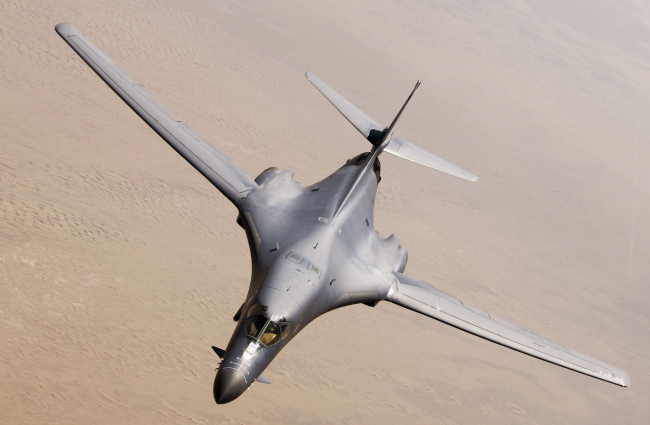The U.S. Air Force will rotate its currently mainland-based B-1B Lancer bombers to its Guam air base from this month, marking the first deployment of the supersonic bomber in the area since 2006 and representing the increased military presence of the U.S. in the Pacific region.
The deployment as of Aug. 6 comes as North Korea steps up its nuclear and ballistic missile threats against South Korea and the U.S., under orders from leader Kim Jong-un.
Last week, Seoul’s Defense Ministry said that the North fired 31 ballistic missiles since Kim rose to power in 2012, nearly double the 16 missiles fired in the 17 years Kim Jong-il -- Kim’s father and the former leader -- was in power.
The deployment as of Aug. 6 comes as North Korea steps up its nuclear and ballistic missile threats against South Korea and the U.S., under orders from leader Kim Jong-un.
Last week, Seoul’s Defense Ministry said that the North fired 31 ballistic missiles since Kim rose to power in 2012, nearly double the 16 missiles fired in the 17 years Kim Jong-il -- Kim’s father and the former leader -- was in power.

“With a large weapon capacity and exceptional standoff strike capability, the B-1 will provide U.S. Pacific Command and its regional allies and partners with a credible, strategic power projection platform,” the PACOM said in a statement, announcing the Lancer’s deployment at the Andersen Air Force Base in the U.S. Pacific territory.
“This forward deployed presence demonstrates continuing U.S. commitment to stability and security in the Indo-Asia-Pacific region.”
The bombers will be accompanied by some 300 airmen from Ellsworth Air Force Base in South Dakota.
Nicknamed by its crew “The Bone,” the 1980s-introduced B1B is a variable-sweep wing, jet-powered strategic long-range conventional bomber with Mach 1.2 -- or 1,468 kilometers per hour -- speed capability. It can hold 24 cruise missiles and can carry up to 3,401 kilograms.
Developed by Rockwell -- now part of Boeing -- for nuclear capacities, Lancer was converted to its exclusively conventional combat role in the mid-1990s. Its payload includes the AGM-158 Joint Air to Surface Standoff Missile and GPS-guided bombs like the GBU-38.
The bombers had been actively involved in a bombing campaign against the Islamic State group before returning home for maintenance. “The Bone” had reportedly dropped about a third of all coalition weapons on the group in Iraq during its deployment from July 2015 to January.
Lancer will be replacing the B-52 Stratofortress bombers. The B-1 models are known to be able to carry triple the payload of their decades-older predecessor.
The swapping of strategic bombers follows a nonfatal B-52 crash that took place at the Guam base in May. Officers had said that the incident did not appear to be an attack, though it is unclear if the investigation has concluded.
The B-1B deployment is expected to boost the military presence of the U.S. in the Pacific region, where it has had run-ins in the South China Sea with China and on the Korean Peninsula over deployment of the Terminal High Altitude Area Defense missile system.
China has claimed the deployment will infringe upon its strategic interests in the region, while the allies respond that the missile defense system is strictly for defending against military threats from Pyongyang.
The U.S. military is currently operating the THAAD system in Guam.
By Yoon Min-sik(minsikyoon@heraldcorp.com)
“This forward deployed presence demonstrates continuing U.S. commitment to stability and security in the Indo-Asia-Pacific region.”
The bombers will be accompanied by some 300 airmen from Ellsworth Air Force Base in South Dakota.
Nicknamed by its crew “The Bone,” the 1980s-introduced B1B is a variable-sweep wing, jet-powered strategic long-range conventional bomber with Mach 1.2 -- or 1,468 kilometers per hour -- speed capability. It can hold 24 cruise missiles and can carry up to 3,401 kilograms.
Developed by Rockwell -- now part of Boeing -- for nuclear capacities, Lancer was converted to its exclusively conventional combat role in the mid-1990s. Its payload includes the AGM-158 Joint Air to Surface Standoff Missile and GPS-guided bombs like the GBU-38.
The bombers had been actively involved in a bombing campaign against the Islamic State group before returning home for maintenance. “The Bone” had reportedly dropped about a third of all coalition weapons on the group in Iraq during its deployment from July 2015 to January.
Lancer will be replacing the B-52 Stratofortress bombers. The B-1 models are known to be able to carry triple the payload of their decades-older predecessor.
The swapping of strategic bombers follows a nonfatal B-52 crash that took place at the Guam base in May. Officers had said that the incident did not appear to be an attack, though it is unclear if the investigation has concluded.
The B-1B deployment is expected to boost the military presence of the U.S. in the Pacific region, where it has had run-ins in the South China Sea with China and on the Korean Peninsula over deployment of the Terminal High Altitude Area Defense missile system.
China has claimed the deployment will infringe upon its strategic interests in the region, while the allies respond that the missile defense system is strictly for defending against military threats from Pyongyang.
The U.S. military is currently operating the THAAD system in Guam.
By Yoon Min-sik(minsikyoon@heraldcorp.com)









![[Hello India] Hyundai Motor vows to boost 'clean mobility' in India](http://res.heraldm.com/phpwas/restmb_idxmake.php?idx=644&simg=/content/image/2024/04/25/20240425050672_0.jpg&u=)









